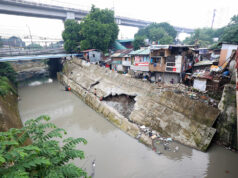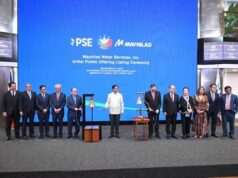Wawa project to cost Razon P15-20 billion
BUSINESSMAN Enrique K. Razon, Jr. has placed the capital outlay in developing the Wawa water supply project at around P20 billion, exceeding the cost of a separate Chinese-funded dam project.
“That’s my first foray [in water]. The project is, I would say between $250 [million] and $300 million — P15-20 billion,” Mr. Razon told reporters after the annual stockholders meeting of another company he leads.
The project is the 500-million-liters-per-day (MLD) water supply facility at the Wawa catchment area in Rizal province that will traverse the municipality of Rodriguez and the city of Antipolo.
“We’re proposing to develop the Wawa bulk water supply, and Manila Water [Co., Inc.] is the offtaker. In other words, they’ll buy the water that we produce,” Mr. Razon said.
Prime Metroline Infrastructure Holdings, Inc. (Prime Infra), a company he controls, is handling the project.
Mr. Razon, president and chairman of listed International Container Terminal Services, Inc., said he ventured into the water supply business despite the existing issues faced by the industry.
“Magulo naman tayo eh (Doing business is really complicated, anyway). If you look at one thing, what’s going to be short in the future lest something has been done is water. When was Angat dam built? Obviously the population is growing. Metro Manila will be double its size by 2040. You need water, it’s the one thing you need the most. So it doesn’t take a lot of thinking to know it’s the business you should get into,” he said.
The project itself depends on Metropolitan Waterworks and Sewerage System (MWSS) granting its approval. The state regulator’s administrator had said the clearance would rest on Mr. Razon’s Prime Infra withdrawing a court-issued restraining order on the water rights for an adjacent project.
“Once everybody agrees, may [there will be a] final signed agreement; of course, if all the parties have compromised and come to an agreement,” he said, without giving details.
On April 15, Prime Infra and Manila Water presented the results of their joint technical study on the Wawa water supply project to MWSS Administrator Reynaldo V. Velasco and the agency’s board.
Prime Infra said the technical study was aimed at sorting out the best technical scheme for the project, considering cost, risks, timeline and maximization of water supply source.
The study laid down a plan to ensure water supply security in Manila Water’s service area with a new water source delivering at least 500 MLD; accelerate water availability by immediately delivering 80 MLD by 2021; as well as provide operational flexibility and reliability to bring water where it is needed most.
In a statement last week, Prime Infra President and Chief Operating Officer Guillaume Lucci said: “We are excited to present the project for approval of the MWSS board on April 23, 2019 and get things going immediately. We hope to break ground by 2020’s dry season so we can deliver first water by 2021. At its full capacity, the project will boost Manila Water’s current available water supply by about 30%.”
Earlier this month, Mr. Velasco said his office was also looking at other water supply projects, including the 600-MLD Kaliwa dam, which is targeted for completion by 2023.
Kaliwa dam has faced criticism because its P12.1-billion cost is to be funded 85% by an official development assistance (ODA) from China and 15% by MWSS. Critics claim the Chinese loan carries provisions that are not favorable to the Philippines.
The new water supply projects are meant to lessen the dependence on Angat dam, which was built in 1967 and supplies about 96% of Metro Manila’s water requirement at 4,000 MLD.
Mr. Razon said his focus is on the Wawa water project, dismissing suggestions of also going into desalination.
“Desalination probably costs about P80-90 per cubic mater. Reservoir water costs about P15-17. If you’re willing to pay, then no problem,” he said.
“We’re not building enough reservoirs to keep the water. After Angat, wala na eh (nothing followed). So you add Wawa, you add Kaliwa, it will be maybe, 30-40 years before you need to desalinate,” he added. — Victor V. Saulon



